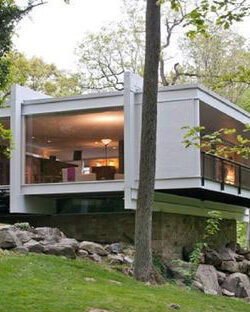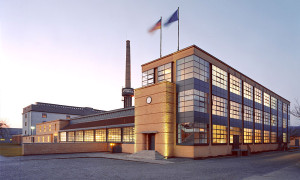
What is Mid-Century Design?
 Mid-Century Modern is an architectural, interior, product and graphic design aesthetic that is characterized by simplicity, openness, and sensitivity to site and nature. Its origins are traced directly from the celebrated German Bauhaus School.
Mid-Century Modern is an architectural, interior, product and graphic design aesthetic that is characterized by simplicity, openness, and sensitivity to site and nature. Its origins are traced directly from the celebrated German Bauhaus School.
Bauhaus founder Walter Gropius began his ascent to leadership in the modern movement with his 1911 design for a shoe factory. Gropius designed the building on a steel skeleton and included an unusual quantity of glass, creating an open, airy feeling. That innovative design brought him the commissions he needed, and his success was a major factor in the rise of avant garde Modernist ideals.
Gropius believed creativity could be applied in any area, and parlayed his success as an architect into commissions to design everything from furniture to a sleeping car for the German railway, and even a diesel locomotive. The arc of Mid-Century design eventually encompassed the fields of fine art, furniture, lighting, ceramics, advertising, automobiles, and clothing. The Bauhaus led the modern movement in Europe and then transplanted its roots in the New World when the school was closed down by the Nazi regime (the anti-Classical ideals of the Bauhaus were considered “decadent” by the Nazis).Gropius brought his genius to America, as did his protégé, Marcel Breuer.
 On the East Coast, Breuer and four of his students at Harvard (Philip Johnson, Landis Gores, Eliot Noyes, and John Johansen) were hugely influential, and were dubbed “The Harvard Five.”
On the East Coast, Breuer and four of his students at Harvard (Philip Johnson, Landis Gores, Eliot Noyes, and John Johansen) were hugely influential, and were dubbed “The Harvard Five.”
These five built glass, wood, steel, and fieldstone houses in the rural area around New Canaan, Connecticut during the period from the late 1940s to the late 1960s. Their work was a shock to the local system, totally unlike the staid clapboard New England colonials that were the norm. The quiet little town saw an influx of gawkers and “house tour” participants, and the bold new designs were vilified by locals with descriptions such as “an architecture as gracious as Sunoco service stations,” “cracker boxes,” and “packing boxes.” One unhappy neighbor penned this little verse….
“They’re lousing up the countryside with buildings most alarming,
It isn’t like New Canaan, where everything’s been charming.”
Pure Mid-century home design eventually took a back seat to the “modern” mutations of 1970s suburban tracts, and then to the “McMansions” of the 1980s and later. But in more recent years, it has had a roaring comeback.
Some of that surge of interest can probably be attributed to Baby Boomers who have become nostalgic for their childhood environment. However, the Mid-Century cachet seems to be even more attractive to the fast-paced, tech-savvy young people who are now in the process of building, renovating, and buying all the accoutrements associated with home design. The return to favor of the ideals expressed in Mid-Century architecture has brought on a wave of skyrocketing prices for the furnishings and art that were languishing in second-hand shops and attics for years.
Here are a few examples of striking, well-known mid-century homes designed by some of the architects who became “stars” of the period . . .
Glass House: The revolutionary Glass House, New Canaan, CT was designed in 1949 by architect Philip Johnson as his own residence. Interior space is divided by low walnut cabinets and a brick cylinder that contains the bathroom. Glass House is set in a beautiful open landscape.
VDL Studio and Residence: Architect Richard Neutra originally designed a 1933 research house in Silver Lake, Calif., and named it after his benefactor, Dr. C.H. Van Der Leeuw. After a fire destroyed the original structure, Neutra rebuilt in 1966, calling the updated abode VDL House II.
Farnsworth House: Designed by Ludwig Mies van der Rohe, this 1951 house in Plano, Ill., is known for its transparency and simplicity.
Stahl House – Case Study House 22: This spectacular 1960 glass house seems to float above Los Angeles in the Hollywood Hills, was designed by Pierre Koenig.
Much of Frank Lloyd Wright’s genius lay in his ability to be a fearless innovator. His idea of building decentralized, affordable communities in harmony with nature eventually led to his design of the “Usonian” house. There are a number of these houses throughout America, and Westchester County’s Pleasantville is home to an entire community called “Usonia.” Designed and planned by Wright in the late 1940s, the 47-plot site stands as a testament to his belief in “organic” community living. About sixty per cent of the property is forest and meadowland. Wright’s love of the natural was present in all of his work, and he once said that “nature is the only body of God we shall ever see.”
Wright coined the name Usonia as a sort of acronym for “United States of North America,” a tribute to the American way of life and his desire to interpret it for the modern world. He designed large beautiful homes for some wealthy clients, but his fond dream was to allow America’s middle class families to have simple homes of great beauty and style that would offer them a connection to the natural world in their everyday lives.
He short-circuited many building costs to create affordability. Usonian homes were designed to be built on flat slabs (no basement digging required) fitted with radiant heat. The plan followed a compact L-shape with two wings. Wright cut out layers of materials that were in general use….lathe, plaster, paint, wallpaper…. and used wood, concrete and brick in their natural state. He designed built-in furniture, storage and lighting. Wright originated the use of the “carport” to eliminate the cost of building a garage. Usonian houses are sited to make the best use of the particular landscape, and are built largely from materials native to the geographic area.
Wright designed three of the homes at Usonia himself, and the others were designed by architects who followed his style and sensibility. They include Paul Schweikher, Theodore Dixon Bower, Ulrich Franzen, Kaneji Domoto, Aaron Resnick and David Henken (an engineer and Wright apprentice).Until very recent years, these homes rarely changed hands, and original owners would often add to them rather than leave them.
Ironically, Wright’s fame and lasting style and the high cost of housing in Westchester have increased the value of these homes to a level that makes them unattainable for the middle-class buyer. However, his impact on the American mid-century influenced the development of open-flow ranch style homes and even of the attractive pre-fabricated homes marketed today.
